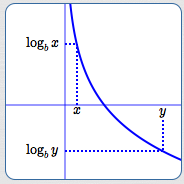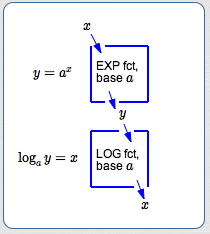 Logarithmic Functions: Review and Additional Properties (Part 1)
Logarithmic Functions: Review and Additional Properties (Part 1)
(This page is Part 1. Click here for Part 2.)
A logarithmic function is a function of the form $\,f(x) = \log_b x\,$ for $\,b \gt 0\,$ and $\,b\ne 1\,.$
‘log base $\,b\,$ of $\,x\,$’
‘$\,\log_b\,$’ (read aloud as ‘log base $\,b\,$’) is the name of the function, and it acts on the input $\,x\,.$
When there's no confusion about order of operations, mathematical convention dictates that we can drop the parentheses used to ‘hold’ the input, and write ‘$\,\log_b x\,$’ (without parentheses) instead of the more cumbersome ‘$\,\log_b(x)\,$’.
If order of operations becomes ambiguous, be sure to include parentheses for clarification. Thus, for example, you should write either $\,\log_b(x + 1)\,$ or $\,(\log_b x) + 1\,,$ but never the ambiguous ‘$\,\log_b x + 1\,$’. (Notice, however, that there is no ambiguity in the expression ‘$\,1 + \log_b x\,$’.)
The number $\,b\,$ in $\,\log_b x \,$ is called the base of the logarithm.
When the base is $\,\text{e}\,,$ the function is called the natural logarithm, and can be written as $\,y = \ln x\,.$ (Note: $\text{e}\approx 2.71828\,$)
When the base is $\,10\,,$ the function is called the common logarithm, and can be written as $\,y = \log x\,.$
Logarithmic functions and their graphs were introduced in the Algebra II curriculum:
- Thoroughly study this earlier section: Introduction to Logarithmic Functions
- Print out an 18-question worksheet to make sure you've mastered all the different problem types.
Additional higher-level information that is important for Precalculus is presented below.
Increasing/Decreasing Properties of Logarithmic Functions
Increasing Logarithmic Functions
When $\,b \gt 1\,,$ $\,f(x) = \log_b x\,$ is an increasing function. That is, for all positive real numbers $\,x\,$ and $\,y\,$:
$$ \cssId{s23}{x \lt y \ \ \Rightarrow\ \ \log_b x \lt \log_b y} $$
It is clear from the graph that the other direction is also true:
$$ \cssId{s25}{\log_b x \lt \log_b y \ \ \Rightarrow\ \ x \lt y} $$Together, we have that for all positive real numbers $\,x\,$ and $\,y\,,$ and for $\,b \gt 1\,$:
Notice that when the base of the logarithm is greater than one, the inequality symbols that compare the inputs ($\,x\,$ and $\,y\,$) and their corresponding outputs ($\,\log_b x\,$ and $\,\log_b y\,$) have the same direction:
This equivalence can be alternatively stated as:

$y = \log_b x\,,$
for $\,b \gt 1\,$
An increasing
logarithmic function
$x \lt y \ \iff\ \log_b x \lt \log_b y$
Decreasing Logarithmic Functions
When $\,0 \lt b \lt 1\,,$ $\,f(x) = \log_b x\,$ is a decreasing function. That is, for all positive real numbers $\,x\,$ and $\,y\,$:
$$ \cssId{s40}{x \lt y \ \ \Rightarrow\ \ \log_b x \gt \log_b y} $$
It is clear from the graph that the other direction is also true:
$$ \cssId{s42}{\log_b x \gt \log_b y \ \ \Rightarrow\ \ x \lt y} $$Together, we have that for all positive real numbers $\,x\,$ and $\,y\,,$ and for $\,0 \lt b \lt 1\,$:
Notice that when the base of the logarithm is between zero and one, the inequality symbols that compare the inputs ($\,x\,$ and $\,y\,$) and their corresponding outputs ($\,\log_b x\,$ and $\,\log_b y\,$) have different directions:
This equivalence can be alternatively stated as:

$y = \log_b x\,,$
for $\,0 \lt b \lt 1\,$
A decreasing
logarithmic function
$x \lt y \ \iff\ \log_b x \gt \log_b y$
Logarithmic Functions are One-to-One
The graphs of logarithmic functions pass both vertical and horizontal lines tests, so they are one-to-one functions. Thus, for all positive real numbers $\,x\,$ and $\,y\,$:
Consequently, logarithmic functions have inverses.
Logarithmic Functions and Exponential Functions are Inverses
Logarithmic functions and exponential functions with the same bases are inverses—they ‘undo’ each other. Roughly:
- If the exponential function with base ‘$\,a\,$’ does something, then the logarithmic function with base ‘$\,a\,$’ undoes it.
- If the logarithmic function with base ‘$\,a\,$’ does something, then the exponential function with base ‘$\,a\,$’ undoes it.
These relationships are firmed up mathematically below.

Drop $\,x\,$ in the ‘exponential function with base $\,a\,$’ box; get $\,y\,$ out the bottom. (See the top box in the diagram above.) This is expressed mathematically as:
$$\cssId{s71}{y = a^x}$$Drop $\,y\,$ in the ‘logarithmic function with base $\,a\,$’ box; get $\,x\,$ out the bottom. (See the bottom box in the diagram above.) This is expressed mathematically as:
$$\cssId{s76}{\log_a y = x}$$Since the exponential and logarithmic functions with base $\,a\,$ are inverses, these two operations are equivalent:
$$\cssId{s78}{y = a^x\ \ \iff\ \ \log_a y = x}$$If one is true, so is the other. If one is false, so is the other. They are true and false at the same time. In other words:
- If the exponential function with base $\,a\,$ takes $\,x\,$ to $\,y\,,$ then the logarithmic function with base $\,a\,$ takes $\,y\,$ back to $\,x\,.$
- If the logarithmic function with base $\,a\,$ takes $\,y\,$ to $\,x\,,$ then the exponential function with base $\,a\,$ takes $\,x\,$ back to $\,y\,.$
‘$\,y = a^x\,$’ is called the exponential form of the equation.
‘$\log_a y = x\,$’ is called the logarithmic form of the equation.

The exponential and logarithmic functions with the same bases ‘undo’ each other!
When
‘EXP fct, base $\,a\,$’
takes $\,x\,$ to $\,y\,,$
then
‘LOG fct, base $\,a\,$’
takes $\,y\,$ back to $\,x\,.$